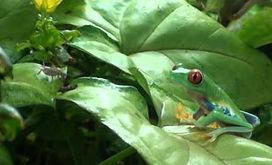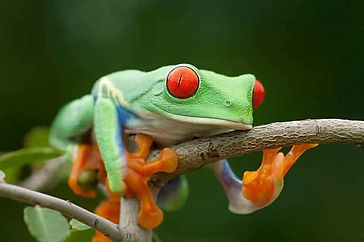All About the
Red-eyed Treefrog

HABITAT AND HISTORY
Red-eyed treefrogs (Agalychnis callidryas) are among the most beautiful and widely recognized of all living amphibians. As a result of their natural glamour, these frogs are commonly featured in nature publications and in advertising. In addition to being the public’s favorite frog, red-eyes are also easy to keep in captivity and are just as common in the vivarium as they are on the billboards.
These medium-sized treefrogs occur throughout the tropical forests of extreme Southern Mexico and the entirety of Central America. They are locally common, and can often be both seen and heard at night when they are most active. Strictly arboreal, red-eyed treefogs make their homes in the forest canopies and during the day seek shelter amongst the dense, tropical foliage.
Red-eyed treefrogs are among the most beautiful and widely recognized of all living amphibians.
SIZE AND APPEARANCE
Mature red-eyed treefrogs are typically between 2 and 2 and a half inches in total length. Females are almost always larger (both in length and bulk), making size one way to differentiate the sexes.
Figures regarding the longevity of this species in the wild are lacking, but they are a hardy species in captivity. Relative to their size, red-eyes can be considered a long-lived tree frog. When properly maintained, life spans of up to 10 years are common.

Females are almost always larger making size one way to differentiate the sexes.

DIET
Red-eyed treefrogs are insectivores, and in captivity will thrive on a diet of appropriately sized crickets and other readily available feeder insects. While some adult frogs will accept a variety of worms, most frogs prefer crickets during all life stages.
Care should be taken that food items are not too large for the animal intended to eat them. While adult red-eyes are more than capable of swallowing even the largest crickets, baby specimens will need tiny crickets, no more than a quarter of an inch long.
Red-eyed treefrogs will thrive on a diet of appropriately sized crickets
All food items should be dusted regularly with a high-quality calcium/vitamin D3 supplement. This is especially important for young, growing frogs, which should receive supplementation at every feeding. Larger frogs can receive this supplement less frequently, as they are done growing and in little danger of metabolic disorders.
In addition to the calcium supplement mentioned above, a reptile multi-vitamin should be utilized as well. Available as a powder (like the calcium), it should be lightly dusted on the prey items once or twice a week.
Always consult the label of both the calcium and vitamin supplement for proper dosing information, as they vary from one manufacturer to another.
HEALTH
Red-eyed tree frogs are generally healthy and easy to care for, especially captive bred frogs. They commonly have few health problems, however, even with a clean environment, proper care and good nutrition, your pet may get sick.
Stress of any sort can reduce the red-eyed tree frog’s immune system, making them susceptible to disease. Stress can be in the form of improper humidity or temperature levels in the habitat, an unclean environment, and too much handling.
Oodinium is one of the most common red-eyed tree frog health issues. It appears as small white or gray spots all over the frog’s skin. This is prevalent among red-eyed tree frogs in captivity and is caused primarily by unclean habitats. If detected early, oodinium can be treated by placing the frog in clean distilled water and thoroughly cleaning the tank.
Red leg disease seems to affect red-eyed tree frogs in captivity. It is thought to be caused by the parasite, aeromonas hydrophyla, which may lie dormant in the frog. It is recognized by reddening of the skin on the frog’s thighs and belly. The physical signs of the disease are lethargy and weight loss. The red-eyed tree frog may also develop bleeding from the mouth and anus and its limbs will become weak.

The best way to prevent further illness is to pay attention to its diet, environment and behavior.
Metabolic bone disease (MBD) in the red-eyed tree frog is caused by a lack of proper nutrition, specifically vitamin D and calcium. The symptoms include lethargy and loss of appetite. Your frog will also stop jumping, as this disease weakens the bones.
Metabolic bone disease is curable, especially if found early. It can be corrected by feeding your frog vitamin and calcium supplements. This can be done by feeding supplement pellets to the crickets you feed the frog, or by dusting the crickets with a calcium powder.
The best way to prevent further illness is to pay attention to its diet, environment and behavior.
BEHAVIOR
Red-eyed treefrogs are known foremost for their huge, bright red eyes, a possible adaptation to nocturnal activity or the central component of a defensive strategy called startle coloration. They are nocturnal and rest during the day. If a predator were to happen upon one, the frog would awaken, and its eyes would suddenly pop open. The sudden brightness of their red eyes might startle the predator enough to give it just enough time necessary for the agile frog to jump to safety.
Red-eyed treefrogs are excellent climbers and have suction-cup toes that help them attach themselves to the underside of leaves, where they rest during the day. They can also be found clinging to branches and tree trunks throughout their habitat and are capable swimmers if necessary.
The musical mating ritual of red-eyed treefrog starts with the loud croaking of one male frog that is quickly joined by the other male in the area with all sharing the common goal of attracting females.
The males are also known to “quiver” to attract females. Quivering occurs when the loud croaking is at its climax. They also inflate their vocal sacs and rise on all fours in an attempt to attract females and deter other males from entering their territory.

Red-eyed treefrogs are excellent climbers and have suction-cup toes that help them attach themselves to the underside of leaves, where they rest during the day.
HABITAT SETUP
Standard all-glass reptile terrariums make ideal enclosures for red-eyed treefrogs. These habitats are easy to clean, available in many different sizes, and retain heat and humidity well. A secure screen top is advisable. This allows for proper ventilation as well as for the proper placement of any necessary light fixtures.
An enclosure no smaller than that of a standard 20-gallon terrarium is recommended for these frogs once adult size is achieved. As many as 3 or 4 of these communal frogs will thrive in such an environment. In smaller enclosures, the animals may injure themselves if they leap across the cage and hit the enclosure wall. Younger frogs may be housed in smaller enclosures, but they grow rapidly and will require larger quarters quite quickly.

Specialized full spectrum lighting is not mandatory, but is necessary for live plant maintenance.
Light
Specialized full spectrum lighting is not mandatory for these frogs to thrive in captivity, but they can benefit from some low output UVB lighting. Use of these lights not only makes it easier to view the animals, but can be used to help grow and maintain a planted tank in addition to providing UVB for the frogs.
Heat
As a tropical species, red-eyed tree frogs should be provided with moderately warm temperatures during the day. Ambient cage temperatures should not exceed the mid-80's, with temperatures between 78 and 84 being optimal. Nighttime temperatures can safely drop into the upper 60's, but slightly warmer nocturnal environments are advised for smaller specimens.
In most parts of the country, little or no supplemental heating will be required during the warmer months of the year. However, if the temperatures within the home drop below those recommended above, extra heat will need to be provided.
Low wattage heat bulbs and heating pads are ideal, as they provide gentle heat without being overly drying. Red or nocturnal bulbs are excellent choices as they can be left on at night and can provide a 24-hour heat source for the frogs.
Substrate
The substrate used for red-eyed tree frogs should be one that promotes healthy levels of humidity but also one that is easy to clean and resistant to mold and fungus. Coconut husk products such as EcoEarth, CocoSoft chips, compressed coconut bricks, or coconut chips are all an ideal choice. Other acceptable choices include cypress mulch, orchid bark, and sphagnum moss.
Landscaping
Red-eyed tree frogs are arboreal and will require a variety of climbing and hiding structures within their habitat. Branches, sticks, cork flats, cork rounds, and both live and artificial plants should be used to create a comfortable and naturalistic environment for these frogs.
When choosing plants (live or plastic), opt for those with large, broad leaves, as these are most similar to those used by the frogs in nature for shelter and sleeping. Additionally, any live plants should be of a species that is tolerant of high heat and humidity, and certain lighting considerations may need to be taken if these plants are to thrive.

The substrate used for red-eyed tree frogs should be one that promotes healthy levels of humidity
Water and Humidity
A large, shallow water dish should always be provided for these animals. While they rarely swim, the large surface area of the water will increase ambient cage humidity and provide an emergency retreat for the frogs should the enclosure become too hot.
Humidity levels within the enclosure should be moderate to high. However, the enclosure contents should not be allowed to become soggy. Rather, one should devise a misting schedule that allows the habitat to remain quite moist for a number of hours, and nearly dry prior to being misted again.
For the vast majority of situations, spraying the contents of the enclosure (substrate, furnishings, cage walls, etc.) twice daily should be sufficient. Hand spray bottles are fine, but automated misting systems are available for more elaborate set-ups or for when the keeper may be away for an extended period of time. In addition to these, a reptile fogger can be used to increase humidity in a very aesthetically pleasing way. The fog can also act as a cooling system during the warmest summer months.
HANDLING AND TEMPERAMENT
Like most frogs, red-eyes do not tolerate excessive handling. While they are harmless and can be safely handled for brief periods of time, they should not be acquired as a "hands-on" pet. In addition to being stressful for the animal, frogs have sensitive skin that can easily absorb pathogens or toxins from our hands.




